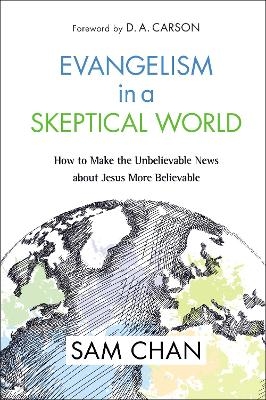
Evangelism in a Skeptical World
Zondervan Academic (Verlag)
978-0-310-53467-9 (ISBN)
- Titel z.Zt. nicht lieferbar
- Versandkostenfrei innerhalb Deutschlands
- Auch auf Rechnung
- Verfügbarkeit in der Filiale vor Ort prüfen
- Artikel merken
Many of the old methods of evangelism no longer work effectively today. We need new methods to communicate the timeless message of the gospel in culturally relevant ways.
In a post-Christian, post-churched, post-reached world, most Christians have been poorly equipped to tell their friends about Jesus. Dr. Chan combines the theological and biblical insights of classic evangelistic training with his own and hard-won insights from missiology on contextualization, cultural hermeneutics, and storytelling.
Every chapter is illustrated with real-world examples drawn from over fifteen years of evangelistic ministry across the globe. These are methods that really work—with university students, urban workers, and professionals—getting past the defensive posture that people have toward Christianity so they can seriously consider the claims of Jesus Christ.
Field-tested and filled with unique, fresh, and creative insights, this book will equip you to share the gospel in today's world and help as many people as possible hear the good news about Jesus.
Sam Chan (PhD, Trinity Evangelical Divinity School; MBBS, University of Sydney) is a public evangelist with City Bible Forum in Sydney, Australia, where he regularly shares the gospel with high school students, city workers, doctors, and lawyers. He is the author of the award-winning book Evangelism in a Skeptical World and regularly speaks at conferences around the world on the practice of evangelism in a post-Christian culture. Sam blogs at espressotheology.com.
Introduction: Why would anyone believe what we say?
A non-believing friend once asked me what Christians believe happens to our bodies and souls after we die. As I explained to him that many Christians believe that our bodies will actually rise from the grave to meet Jesus when he returns, it hit me how unbelievable our message is. Especially to what we might call a post-Christian, postchurched, post-reached audience. Yet most of our evangelism methods were developed in an age when most non-believers at least had a churched upbringing. If Christians today are to tell their friends about Jesus they must understand how the world has changed in the last 30 years and be equipped with new models to tell their friends about Jesus. This book will show you how.
Chapter 1: What must I do for my friend to be saved?
Theology of Evangelism
This chapter begins with the story of Anne, who was invited to speak evangelistically to a playgroup, which was run by her church. The non-Christians loved how Anne’s talk spoke so clearly to their hearts. But the Christians complained that Anne never really told the Gospel because she didn’t use Four Spiritual Laws or mention the words “sin,” “repent” and the “blood of Christ”. There is much confusion as to what we exactly mean by “evangelism.” Christians will differ in their methods, models and message. What we need is a clear Theology of Evangelism.
Chapter 2: Scratch where they itch
How to Craft a Gospel Presentation
This chapter begins with the story of Jim, who became a Christian in 1975 because he loved the news about Jesus dying for him and taking away his guilt. But when Jim tries to tell this message to his teenage daughter she finds it cold and oppressive. Many Christians are stuck with only one chief Gospel metaphor---guilt and forgiveness. But the Bible gives us many other metaphors. We can use these to craft a compelling Gospel presentation that speaks to the needs and wants of today’s audience.
Chapter 3: “I’m happy that you’ve found Jesus but he’s not for me”
The Challenge and Skills of Evangelism to Postmoderns
This chapter begins with the story of Amanda, who grew up in a small-town, with Christian parents who took her to church every Sunday. But when Amanda left home and went to college, she was exposed for the first time to Derrida and deconstructionism. When she tries to tell her friends about Jesus, they respond by telling Amanda that she’s a Christian because she was born in the USA, but had she been born in India she would’ve been a Hindu. They also tell Amanda that her version of the Gospel is merely a social construct that was imposed upon her by her parents. Postmodernism is both a friend and foe to Christianity. It is a friend because it allows us to talk about spiritual beliefs. But it is a foe because it won’t allow the Christian story to be a universal story. As a result, evangelism today will require a whole different set of models and methods to capture the imagination of our audience.
Chapter 4: If Jesus Came Today Would He be a White Man?
Contextualization for Evangelism
This chapter begins with the story of Jane, who is an Asian-American high school student. She is a high achiever and her mother is a true Asian tiger mom. Jane studies for hours each day and dreams of going to Harvard. One day, Jane’s local youth pastor tells her that study has become her “idol.” If Jane’s serious about following Jesus she needs to stop studying so hard and give up her dreams of going to Harvard. But has the youth pastor given the Gospel to Jane, or has he imposed his non-Asian culture as “Gospel” upon Jane? That is, is he converting Jane to the Gospel of Jesus, or is he converting Jane to his own cultural norms? Many Christians can not see the syncretism of their own culture with the Gospel. As a result, when they evangelize, they impose their culture upon the convert. What they should do instead is to contextualize the Gospel.
Chapter 5: The Force Became Flesh
Gospel-
| Erscheinungsdatum | 25.04.2018 |
|---|---|
| Vorwort | D. A. Carson |
| Sprache | englisch |
| Maße | 159 x 236 mm |
| Gewicht | 426 g |
| Themenwelt | Religion / Theologie ► Christentum ► Kirchengeschichte |
| ISBN-10 | 0-310-53467-4 / 0310534674 |
| ISBN-13 | 978-0-310-53467-9 / 9780310534679 |
| Zustand | Neuware |
| Haben Sie eine Frage zum Produkt? |
aus dem Bereich


